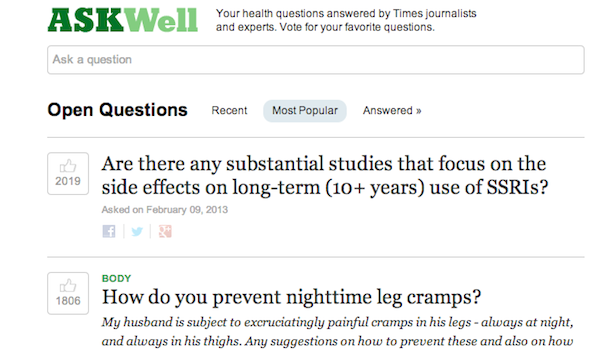
Having trouble with your weights routine at the gym? Trying to decide which type of blueberry has the most nutritional benefit? Maybe you should ask…The New York Times?
That’s the motivation behind the Times’ question and answer site dedicated to health and fitness issues — Ask Well is a kind of Stack Overflow or Quora for health questions from Times readers. Launched in January as a feature on its Well vertical, the Q&A system asks readers to submit their questions, which are then upvoted by the community of readers. But unlike most Q&A sites, Ask Well’s answers come from one source — Times staffers. Well editor Tara Parker-Pope and her team investigate the questions to find the best available information, or recruit other writers from the Times who have expertise in areas like science or health care.
What differentiates their Q&A platform from others on the web, she says, is that the staff puts the same rigor into answers as they would any other reporting. “We want to be gatekeepers and make sure the quality is there and people continue to find us credible and that the content matches what they would read elsewhere on The New York Times,” she said. So for the question on weight training, Well columnist Gretchen Reynolds delved into a research paper that looked at the comparative value of heavier weights vs. more repetitions and spoke with a professor of kinesiology. That approach means more content for Well, but it also flows back into print: Questions and answers from the blog end up in the Science Times section and other places, including the The New York Times Magazine’s upcoming health issue.
Early questions have dealt with topics like the effects of nicotine gum, the effectiveness of flu shots, how to exercise at work, and the proper treatment for shin splints. The questions’ focus on diet and exercise “confirm[s] the idea that people are really looking for areas they can make a difference” in their lives, Parker-Pope said.
Albert Sun, a developer with the Times’ interactive news team, said the paper is using a custom app previously used for Q&As for the Summer Olympics and a Thanksgiving help line. Submitted questions are screened for profanity or other red flags that don’t meet the Times standards, then sent on to the Well staff for moderation. That’s where there’s one additional step: screening for the types of questions best answered by someone who went to med school. “If they ask specific questions about their health problems that are directed at a physician, we’re not going to answer that,” Parker-Pope said.
Marc Lavallee, assistant editor for interactive news at the Times, said one of key components of the Q&A system is that it can merge related questions. Showing users similar queries can cut down on redundancy, but it also can lead to a better answer, Lavallee said.
The Q&A has captured a good response so far, Parker-Pope says, because Well’s audience is already so actively involved in the site. Last April, the Times redesigned and expanded the blog, adding more stories, and community discussion as well as features like quizzes and fitness tools. In relaunching the blog, Well defined its focus not just on providing stories on health, but providing utility as a way to connect with the audience. If you’re planning to run a marathon, Well has tools to help. Need advice on how to keep your aging parents healthy? Well can help there too.
That kind of dynamic makes for a deeper relationship between the blog and readers, Parker-Pope said. Readers on Well feel like they’re a member of a larger community because they can take part in discussions and get a response on their pressing questions, she said: “I just really like the fact that a national newspaper, because of what we can do online, has this opportunity to engage readers on this personal level.” Lavallee said the value in that creates a stronger bond with readers and has a way of making them come back often. The work Well does engaging readers, both on a technical and editorial level, is something that could spread to other corners of the Times, he said.
Another benefit to the Times is that the Q&A site has a built in durability and is very search friendly, Sun said. And if you’re Googling for options on how to relieve back pain, you might be more inclined to click on a link with The New York Times’ name than other Q&A sites. “A part of what makes Well and health content so great is it has this evergreen quality to it,” Sun said. “The answer to how you treat tennis elbow doesn’t change over time.”